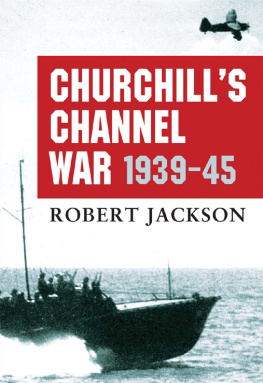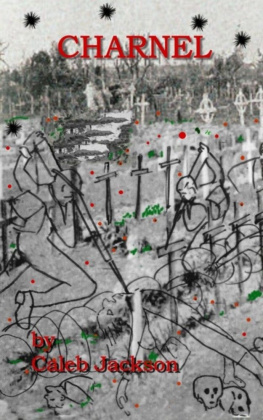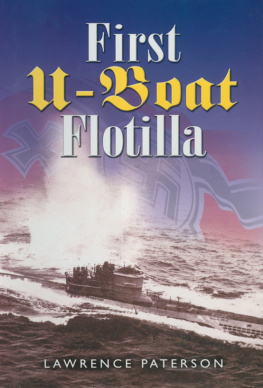C HURCHILL S
CHANNEL
WAR
C HURCHILL S
CHANNEL
WAR
1939 1945
R OBERT J ACKSON
CONTENTS
ACKNOWLEDGEMENTS
In writing this book, I have been indebted to the following people who unstintingly delved into their personal memories and archives to provide me with experiences, photographs and other material. This story is theirs. L.E. Mick Aldridge; H.G. Brown; A.E. Carver; D.J.T. Channell; Arthur Coleman; K. Colyer; Doreen M. Czarnota; Ken Davies; Paul Deacon; Richard and Yvonne Derwent; R.L. Fletcher; A.G. Frampton; Miss M.M.L. Gavan Duffy; Mrs Eileen Haynes; J.L. Hogg; David Horton; Eric Johnson; H.G.F. Male; R.A. Marsdale; Mrs Barbara Morgan; T.C. Parker; H.H. Richards; W.J. Rosser, DFC; Francis Thompson, DSC; R. Thorndike; Norman Wilkinson; Fred Winter.
The quotations in the chapter on the Dunkirk evacuation, by Commander Thomas Kerr, Lieutenant Stewart Gould, F.G. Hutchinson, W.T. Elmslie, Edward Faulkes, DCM, MM, Lieutenant-Commander Archie Buchanan, Tom Collins, W.E. Williamson, Reg Rushmere, Mrs B. Bowden, Troop CSM C.S. Best and Charlie White, were gleaned from correspondence gathered in the compilation of an earlier work of mine: Dunkirk, the British Evacuation, 1940 (Arthur Barker Ltd, London, 1976).
CHAPTER ONE
FIRST ENCOUNTERS: SEPTEMBER 1939 MAY 1940
They called it the Phoney War, and in many respects the term seemed justified. On the continent, from Belgium to the Swiss border, as late summer gave way to autumn and then a freezing winter, an army of men in baggy khaki uniforms that were the hallmark of the French Army faced another army of men in somewhat smarter field grey uniforms, and apart from one small and inconclusive Allied offensive in the Saar region there was little activity.
But on the high seas, as September gave way to October in 1939, the war was already taking its toll. On 3 September, the day Britain declared war on the German Reich, the submarine U-30 torpedoed and sank the passenger liner Athenia off the coast of Ireland with the loss of 128 lives, the U-Boats commander, Kapitnleutnant Lemp, having mistaken the vessel for a troopship. On 14 September the aircraft carrier Ark Royal had a narrow escape when U-39 fired a salvo of torpedoes at her west of the Hebrides. Luckily for the carrier, the torpedoes detonated prematurely and the submarine was sunk by the escorting destroyers Faulknor, Foxhound and Firedrake, which took the German crew prisoner.
Three days later, the Royal Navys luck ran out. U-29, commanded by Kapitnleutnant Schuhardt, was lying in wait in shipping lanes west of the English Channel when a large vessel was sighted. Schuhardt shadowed her, identified her as an aircraft carrier, and put three torpedoes into her. She was the 22,500-ton fleet carrier Courageous, and she went down with the loss of 515 of her crew.
By 13 October the Royal Navys destroyers had evened the score to some extent; Fortuna and Forester sinking U-27 off the west coast of Scotland while Imogen and Ilex sank U-42 off the south-west coast of Ireland. On 14 October, Inglefield, Ivanhoe, Intrepid and Icarus combined their efforts to destroy U-45, but this success came only hours after the Germans had demonstrated the formidable destructive power of a U-boat in the hands of a skilled commander. On the night of 13/14 October, U-47 under Kapitnleutnant Gunther Prien penetrated the defences of Scapa Flow naval base in the Orkneys and sank the battleship Royal Oak with the loss of 833 lives, a disaster that caused a ripple of shock and dismay to spread throughout Britain.
The loss of Courageous and Royal Oak was a serious double blow to the Home Fleet, whose resources, under Admiral Sir Charles Forbes, were already thinly stretched. The main base of the Home Fleet was Scapa Flow, but considerable naval strength was also deployed in the English Channel area at the outbreak of war, amounting to two battleships, two aircraft carriers (one of which was Courageous), three cruisers and 37 destroyers. In addition, minesweepers were deployed at all important points around the British coastline.
The first responsibility of the Royal Navys southern commands was to transport and escort the British Expeditionary Force (BEF) to France soon after the outbreak of war. In preparation for this, British and French naval forces laid the Dover Barrage, a network of minefields extending across the narrowest point of the English Channel. Some 3,600 mines had been sown by the beginning of October 1939, making it virtually impossible for U-boats to use the narrows as a means of egress to the western Atlantic. Three who attempted it in October were all sunk. Until the capture of the French Atlantic ports, the Germans were forced to send their submarines into the Atlantic by the lengthy passage round the north of Scotland.
Mines, in fact, were potentially the most valuable and effective weapons deployed by either side in the early months of the war, and for a time the Germans enjoyed a definite advantage through the use of the magnetic mine, which was detonated by the magnetic field of a vessel passing over it. Such mines accounted for 59,027 tons of British coastal shipping in September and October 1939, and to compound the problem the entire British minesweeping service was equipped to deal only with moored contact mines that detonated on impact.
The Germans laid their mines by surface vessel, submarine (although it was not until later in the war that they developed a specialized minelaying U-boat, the Type XB) and aircraft. Foremost among the latter, in 1939, were the Kstenflieger-gruppen (K.Fl.Gr) of the German Navy, operating Heinkel He 115 floatplanes. The first minelaying mission was flown on the night of 20/21 November 1939, when aircraft dropped mines without loss off Harwich and the mouth of the Thames, repeating the mission the following night. Mines were free-dropped (i.e. without parachutes) from an altitude of 3,280 feet (1,000m), their magnetic or acoustic fuses being armed by water pressure.
These pioneering minelaying sorties were flown by the He 115s of 3/K.Fl.Gr. 906, which on the night of 22/23 November was joined by aircraft of 3/K.Fl.Gr. 106. One of these aircraft dropped a magnetic mine on mud flats near Shoeburyness; the drop was observed from the shore and the authorities alerted. It was obvious that whatever the object was, there was a good chance of recovering it when the tide went out.
The mine was dropped between 2100 and 2200 hours. Before midnight, two highly-skilled naval officers, lieutenant-commanders Ouvry and Lewis from HMS Vernon, the establishment responsible for developing underwater weapons, were called to the Admiralty, where they were interviewed by the First Sea Lord and the First Lord of the Admiralty, at that time Winston Churchill. By 0130 hours on 23 November they were on their way to Southend to set about the task of recovery, and before dawn, in pitch darkness and aided only by a lamp, they found the mine lying about 500 yards below high water mark, but as the tide was coming in they could make only a preliminary inspection before retiring to make their preparations for tackling it after the next high water.
The delicate and highly dangerous operation began early in the afternoon of 23 November, by which time a second mine had been found on the mud not far from the first. Ouvry, assisted by Chief Petty Officer Baldwin, went in first to tackle the mine, with their colleagues Lewis and Able Seaman Vearncombe standing by at a safe distance in case the device exploded. After each pre-arranged step, Ouvry signalled his findings to the back-up team, so that if an accident did happen they could use the knowledge in tackling the second mine. In the event, the efforts of all four men were needed to defuse the weapon, which was made safe and transported to Portsmouth for detailed examination.

















